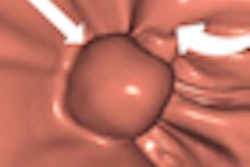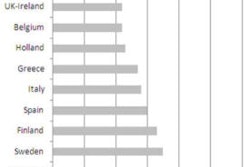BOSTON - A decade-long colorectal cancer screening initiative involving more than a dozen radiologists and thousands of patients across the U.K. delivered positive early results at this week's International Symposium on Virtual Colonoscopy.
In two randomized trials performed concurrently, virtual colonoscopy (also known as CT colonography or CTC) outperformed double-contrast barium enema (DCBE). And VC was equivalent to conventional colonoscopy for cancer detection, with less clinical uncertainty than initial conventional colonoscopy.
The results are only preliminary -- they're based on a minimum 17 months of follow-up (median, 38 months), rather than the minimum three years that the research team, led by Steve Halligan, MD, from University College London (UCL), is waiting for before they submit the results for peer-reviewed publication.
But the early numbers gave high marks to the virtual exam when deployed in one of the largest symptomatic populations ever studied. CTC missed fewer cancers in symptomatic patients randomized to either double-contrast barium enema or CTC, and, like colonoscopy, missed no cancers in the VC-plus-conventional-colonoscopy arm.
"There were two parallel trials, one comparing CTC to colonoscopy, and one comparing CTC to barium enema," explained UCL's Stuart Taylor, MD, in his talk. Unlike most CTC trials to date, the Special Interest Group in Gastrointestinal and Abdominal Radiology (SIGGAR) studies examined patients who were concerned enough about their symptoms to get tested. The organization is now known as BSGAR, or British Society of Gastrointestinal and Abdominal Radiology.
"There's a huge focus on screening, but in the U.K. and a lot of European countries, the bulk of our work is actually in symptomatic patients -- the patients who come to their primary care physicians with a bit of weight loss, rectal bleeding; have they got a cancer?" Taylor said.
"If you go back to the literature in the early years, most studies were actually in symptomatic patients, and there's good evidence that CTC does quite well in detecting cancers," he said.
In any case, the trials' modalities of choice might seem odd because the double-contrast barium enema is clearly going out of style. In a nutshell, DCBE is cheap but uncomfortable, and it's relatively insensitive versus the alternatives. Younger radiologists are loath to perform it, and DCBE wasn't easy to recruit patients for either, Taylor said.
But in the U.K. there are still a fair number of them being performed, and questions regarding DCBE's efficacy versus CTC have remained unanswered in terms of direct comparison. The trial was funded in 2002 by the U.K.'s Health Technology Assessment program.
CTC versus barium enema
Halligan, along with co-investigators Richard Lilford, MD, from the University of Birmingham; David Burling, MD, and Taylor from UCL; and a dozen other BSGAR radiologists around the U.K., examined a total of 2,541 patients 55 years and older with DCBE and 1,280 with CTC.
"Our end point for this trial was not the smaller polyps -- it was an established cancer or a polyp of more than 1 cm -- something that could potentially cause the symptoms in these patients," Taylor said. Results are expressed per patient based on the largest lesion, he added.
In the DCBE arm, equivocal results led 19% (n = 438) of patients to have a second test. A total of 23% (n = 272) in the CTC arm went on to have a second test. A second test was performed when the first test yielded a suspected "end point" (cancer or large polyp) that needed confirmation.
Significantly more patients had a suspected end point following VC (12%, n = 140) versus DCBE (8%, n = 182) (p < 0.005), Taylor said. At the same time, CTC answered the clinical question far more definitively than barium enema. And while a large number of patients (9%, n = 204) had "persistent clinical uncertainty" after DCBE, only 4% (n = 47) had persistent clinical uncertainty after CTC (p < 0.05), he said.
"The take-home message at this point is that significantly less CTCs had persistent clinical uncertainty after they've had their primary test," Taylor said.
But do these "suspected end points" represent real pathology? There was no significant difference (p = 0.28) in the frequency of confirmed end points between the tests, he said.
In DCBE, 1,111 (61%) of 182 suspected end points were confirmed by histology. In CTC, 77 (55%) of 140 suspected end points were confirmed.
Suspected pathology on barium enema was less frequently proven at follow-up. In 12 cases with persistent uncertainties following DCBE, follow-up yielded five cancers and four polyps.
By contrast, in nine cases with suspected end points in CTC, follow-up yielded one cancer and eight polyps -- all in patients in whom a smaller lesion was suspected at CTC, Taylor said. No end point was found in any patient about whom there was persistent uncertainty following CTC.
"The bottom line is that if you feel your CTC is probably normal, then you're probably right," while uncertainty after DCBE often harbors pathology, Taylor said.
In addition, more end points were detected at CTC (4.8% of patients) versus DCBE (6.7%, p = 0.016), showing that "CTC detects significantly more cancers and large polyps than barium enema," Taylor said.
At a median follow-up of 38 months (minimum, 17 months), DCBE missed eight cancers, including four in the cecum, two in the ascending colon, one in the transverse colon, and one sigmoid, yielding a false-negative rate of 9.6% (75 diagnosed, eight missed). CTC missed a single cancer in the sigmoid colon, yielding a false-negative rate of 2.3% (42 diagnosed, one missed). Staging information is not yet available.
"CTC detects more large cancers and polyps than barium enema, and that's good news," Taylor said.
CTC versus colonoscopy
In the second randomized trial, a total of 1,057 patients received colonoscopy and 533 underwent virtual colonoscopy, Taylor said. Clinical uncertainty following the first test led 70 (7%) colonoscopy patients and 155 (29%) CTC patients to have a second test, meaning significantly fewer repeats for the colonoscopy group (p < 0.01).
Postcolonoscopy, the second test was performed due to inadequate visualization in 70 patients (7%) -- i.e., in all patients undergoing a second test.
Post-CTC, the second test was performed due to inadequate visualization in 18 (4%) patients, due to a suspected lesion in 129 (24%) patients and due to a suspected end point (large polyp or cancer) in 68 patients (p = 0.008).
The end point was confirmed in 49 (72%) of these 68 patients for a positive predictive value of 75% for cancer and 52% for large polyps, Taylor said.
CTC revealed suspected polyps 9 mm or smaller in 47 patients, Taylor said. Further testing confirmed three polyps 1 cm or larger, but no cancers. For the 18 patients with persistent uncertainty after CTC, further testing confirmed no cancers but one polyp larger than 1 cm.
There is significantly less clinical uncertainty following CTC than colonoscopy, and end points suspected frequently by CTC have a high positive predictive value, Taylor said.
"So with CTC, if you don't think there's going to be a large polyp or cancer, you're almost certainly going to be correct."
End point detection rates included 113 (11%) exams in colonoscopy versus 53 (10%) in CTC (p = 0.6), meaning that detection rates for cancers and large polyps did not differ significantly between the colonoscopy and CTC groups, Taylor said.
At follow-up (median, 38 months; minimum, 17 months), detection rates were 100% for both, meaning that no cancers were missed by either modality.
"Results of the SIGGAR trial show that CTC is an excellent diagnostic test for patients with symptoms suggestive of colorectal cancer," Taylor concluded. "It should replace the barium enema -- it's a better test than barium enema, and CTC is equivalent to colonoscopy in this context."
By Eric Barnes
AuntMinnie.com staff writer
October 27, 2010
Related Reading
VC advocates tout aggressive strategy for screening coverage, October 26, 2010
Higher colonoscopy complication rates found in seniors, October 19, 2010
Study reveals lesions most likely to be dismissed by VC CAD, January 14, 2010
CAD catches most flat polyps on virtual colonoscopy, December 16, 2009
Two new VC trials under way in Europe, November 22, 2005
Copyright © 2010 AuntMinnie.com


















